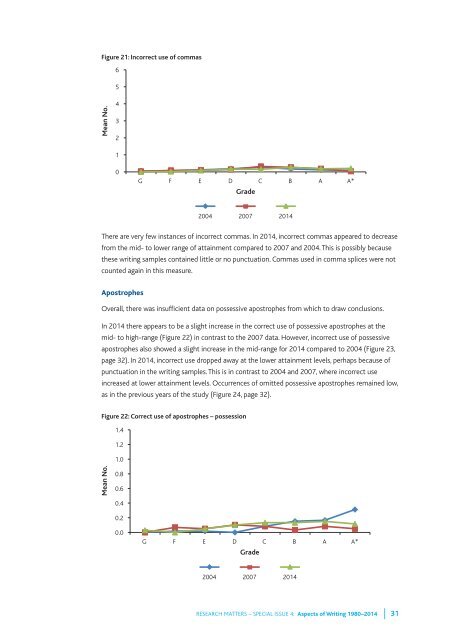Research Matters
N6fqJH
N6fqJH
You also want an ePaper? Increase the reach of your titles
YUMPU automatically turns print PDFs into web optimized ePapers that Google loves.
Figure 21: Incorrect use of commas<br />
6<br />
5<br />
Mean No.<br />
4<br />
3<br />
2<br />
1<br />
0<br />
G F E D C B A A*<br />
Grade<br />
2004 2007 2014<br />
There are very few instances of incorrect commas. In 2014, incorrect commas appeared to decrease<br />
from the mid- to lower range of attainment compared to 2007 and 2004.This is possibly because<br />
these writing samples contained little or no punctuation. Commas used in comma splices were not<br />
counted again in this measure.<br />
Apostrophes<br />
Overall, there was insufficient data on possessive apostrophes from which to draw conclusions.<br />
In 2014 there appears to be a slight increase in the correct use of possessive apostrophes at the<br />
mid- to high-range (Figure 22) in contrast to the 2007 data. However, incorrect use of possessive<br />
apostrophes also showed a slight increase in the mid-range for 2014 compared to 2004 (Figure 23,<br />
page 32). In 2014, incorrect use dropped away at the lower attainment levels, perhaps because of<br />
punctuation in the writing samples.This is in contrast to 2004 and 2007, where incorrect use<br />
increased at lower attainment levels. Occurrences of omitted possessive apostrophes remained low,<br />
as in the previous years of the study (Figure 24, page 32).<br />
Figure 22: Correct use of apostrophes – possession<br />
1.4<br />
1.2<br />
1.0<br />
Mean No.<br />
0.8<br />
0.6<br />
0.4<br />
0.2<br />
0.0<br />
G F E D C B A A*<br />
Grade<br />
2004 2007 2014<br />
RESEARCH MATTERS – SPECIAL ISSUE 4: Aspects of Writing 1980–2014 | 31


